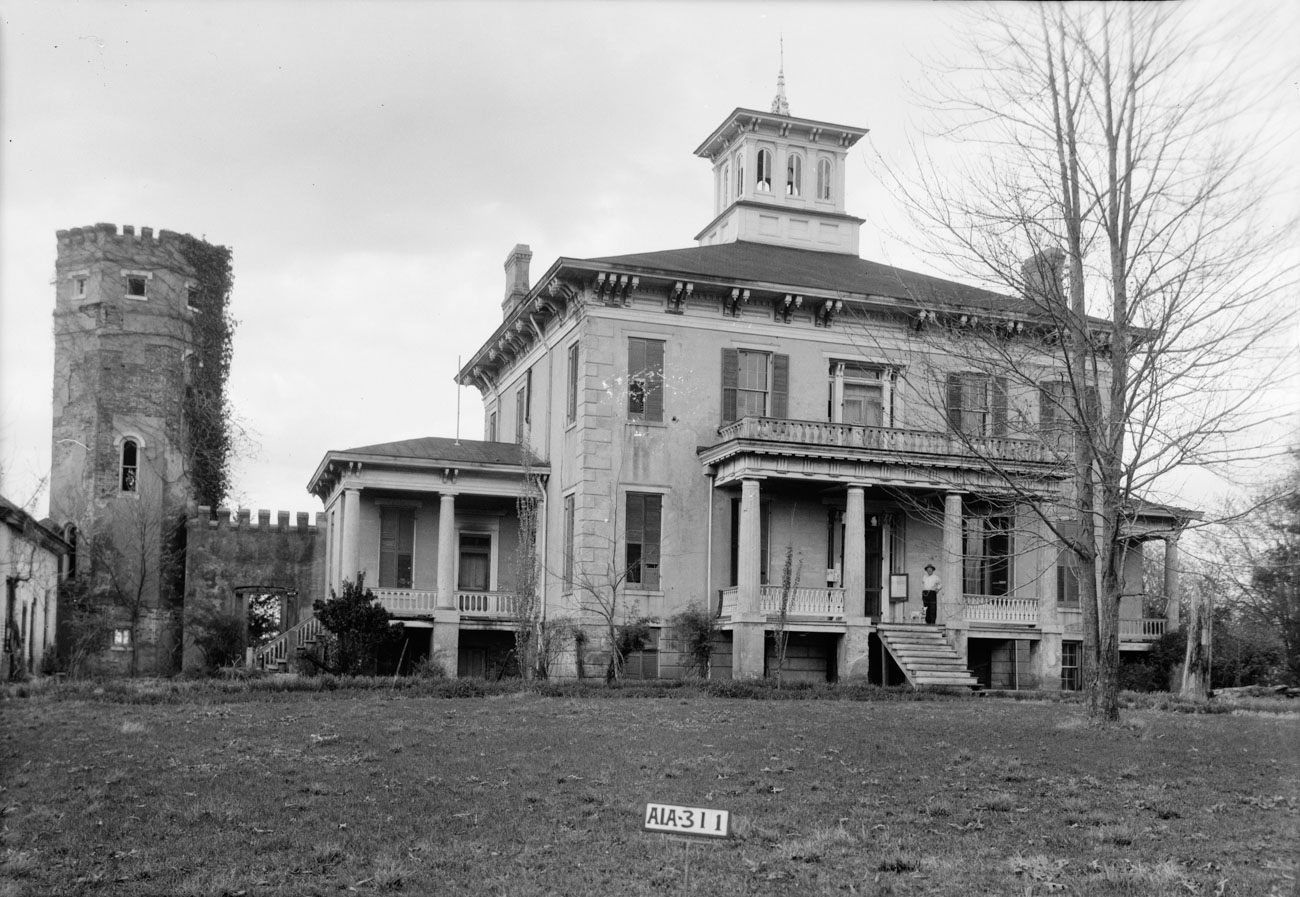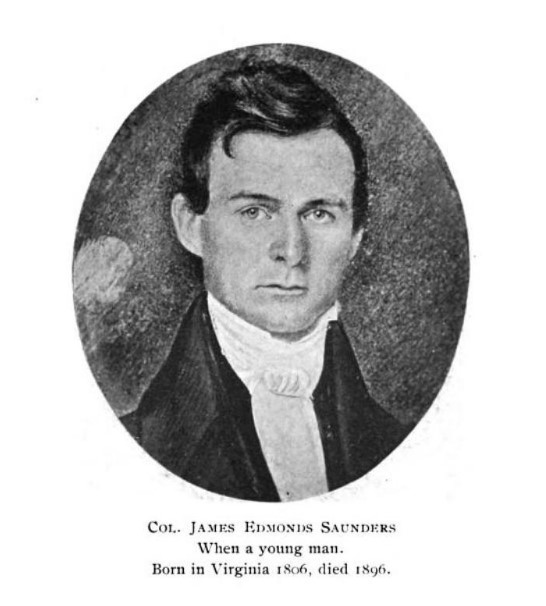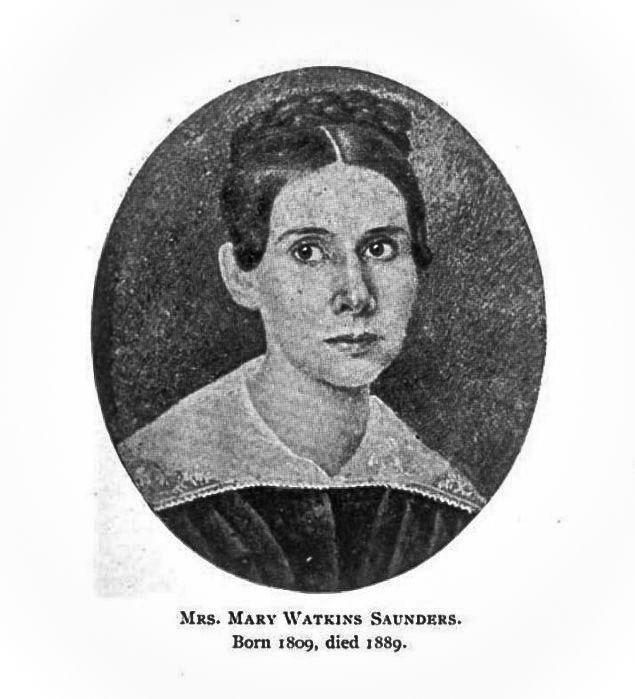| City/Town: • Town Creek |
| Location Class: • Residential |
| Built: • 1858 | Abandoned: • ~1950 |
| Status: • Demolished |
| Photojournalist: |
Table of Contents
Saunders Ancestry
Dr. Edward Saunders was known as a “chirurgeon”, an archaic term for a surgeon. He was already seated in Northumberland County, Virginia, in 1658. In 1669, as one of the justices for the county, he was administering both medicine and law, pari passu, and in drastic doses, no doubt. His commission from the Royal Governor Lord Berkeley as “one of the king’s justices for Northumberland County” is yet preserved in the old Records at Heathsville. Later, his descendants lived in the adjoining county of Lancaster on the Wicomico River, in Wicomico Parish (which was included in both counties), and a record of these is preserved at Lancaster C. H.
Edward’s great-grandson, Thomas Saunders Sr. was born on June 18, 1739, and was removed to Brunswick County, after the Revolutionary War. He and his four brothers served with great credit in the American army during the war in Virginia and North Carolina.
Reverend Turner Saunders was born on January 3, 1782, the second son of Thomas Saunders Sr. Turner married Frances Dunn and moved to Franklin, Tennessee in 1808 along with his brother-in-law, Major David Dunn. In 1822 he and his wife moved to Courtland, Alabama where he would later build his Saunders Hall plantation house.
Col. James E. Saunders
His son, James Edmonds Saunders, was born on May 7, 1806, in Brunswick, Virginia, prior to the family’s move to Tennessee. In 1821, he attended Old Harpeth Academy and later attended the University of Georgia the following year when Reverend Moses Waddell was its president.
On July 14, 1824, at the age of eighteen, he married fifteen-year-old Mary Frances Watkins, the eldest daughter of his neighbor, Major Robert H. Watkins. The newlywed couple moved to Nashville, Tennessee where James was installed in the law office of Ephraim H. Foster and Francis B. Fogg. His first years of practice began in Moulton, Alabama in Lawrence County. One of his earliest clients was Naomi Knox Leetch, the aunt of future president James K. Polk, who when visiting her in 1927, formed a life-long friendship with James. In 1828, James formed a law partnership in Courtland, Alabama with Judge John James Ormond, who later served on the Supreme Court of Alabama.
He was elected to the State Legislature in 1835. He was also President of the Board of Trustees from the beginning of the nearby Lagrange College which was founded in 1830 by the Southern Methodist Church. In 1840, James was the acknowledged party leader in the Lower House of the General Assembly of Alabama. As chairman of its judiciary committee, his strength in a debate, and graceful bearing, gave him great distinction throughout the State.
His arduous practice and public speaking had so impaired his health that in 1843 he moved to Mobile, Alabama where he was appointed the collector of customs by President James K. Polk. He became director of the Bank of Mobile and formed a cotton commission house with his brother-in-law, General Benjamin McFarland Bradford. When his eldest son Robert came of age, the firm became known as “James E. Saunders & Son”. In 1852, he served the State again as elector for Franklin Pierce and William Rufus de Vane King.
War Between the States
Saunders was a strong anti-secessionist and worked devotedly to keep the South from seceding from the Union. In 1860, he served as elector for Stephen A. Douglass and was installed as president of Douglass’s convention which convened at Montgomery, Alabama on June 4, 1860, “in a vain hope of averting the swift-descending horrors of civil war.” When the decision was made for Alabama to secede from the United States on January 11, 1861, Saunders joined the ranks of the Confederate Army. Saunders explains the decision, “And since he could not serve his country in peace, he would defend her in war—white-haired and enfeebled as he was.“
His eldest son, Major Robert Turner Saunders, served on General Cocke’s staff in Virginia. His second son, Dr. Dudley Dunn Saunders, was a surgeon at the hospital post established in Chattanooga, Tennessee. James Saunders was given the rank of Colonel and was in charge of fortifying the defenses of Forts Hindman and Henry, an order given directly to him by Governor John Gill Shorter. Colonel Saunders served under General Nathan Bedford Forrest during the First Battle of Murfreesboro on July 13, 1863. During the battle, he was severely wounded having been shot through his right lung but recovered and returned to writing on horticulture, and carrying on his planting interests.
According to Saunders, General Forrest visited his home at Rocky Hill two weeks prior to his death in 1877, and handed him an official list of those wounded and killed, and taken prisoner at the First Battle of Murfreesboro which Saunders later had published for preservation. In 1880, Colonel Saunders began a series of letters in his local county paper relating to the Early Settlers of Lawrence County, Alabama, and the Tennessee Valley. These letters continued until 1889. They were later compiled and published in 1899 by his granddaughter, Elizabeth Saunders Blair Stubbs.
Rocky Hill Castle
The land Rocky Hill Castle was built upon was first bought by Mr. Norment of Virginia and a log cabin stood on the hill prior to James Saunders’s ownership. The large rocks on the hill were described by him as “so thickly strewn, his horse could scarce pick his way among them,” hence the name Rocky Hill. Reverend Freeman Fitzgerald and his wife Elizabeth were the second owners of the land. James eventually amassed 640 acres and it was here, three miles west of Courtland, that he had a commodious residence constructed for his family in 1832.
Desiring a grander dwelling, Colonel Saunders demolished the home he had built on Rocky Hill and began construction of what would be known as Rocky Hill Castle in 1858, although many referred to it simply as “The Big House”. The Civil War halted its construction in 1861, although the house was largely complete by that time. The house served as a Confederate hospital during the war, with several soldiers buried in the nearby Saunders family cemetery.
The architect, who remains unknown, utilized a combination of the Greek Revival and Italianate architectural styles. The two-story house was a rectangular stuccoed brick structure over a raised basement and featured one-story side wings, one-story Doric porticoes centered on the front and rear, and was topped by a large cupola. Evidently, the bricks used in its construction were hand-made by slaves. The interior of the house featured some of the most elaborate woodwork and plasterwork in the state. Other features of the house were an impressive walnut staircase, double parlors, and Italian marble mantles.
In the book Ante-Bellum Mansions of Alabama, author Ralph Hammons writes, “Many notables were entertained at the mansion during the course of the war. On one occasion the Military Court of the Army of Tennessee held a meeting there. The members attending consisted of the following: Colonel William H. Saunders, brother of the builder; Judge John Sale of Aberdeen, Mississippi; Colonel William Dowd; and the learned educator, J. L. M. Curry of Talladega, Alabama, later Minister to Spain. General Pierre Beauregard and his staff dined there once, and a staff member, Colonel William Brent, later became the father-in-law of one of the young Saunders girls.“
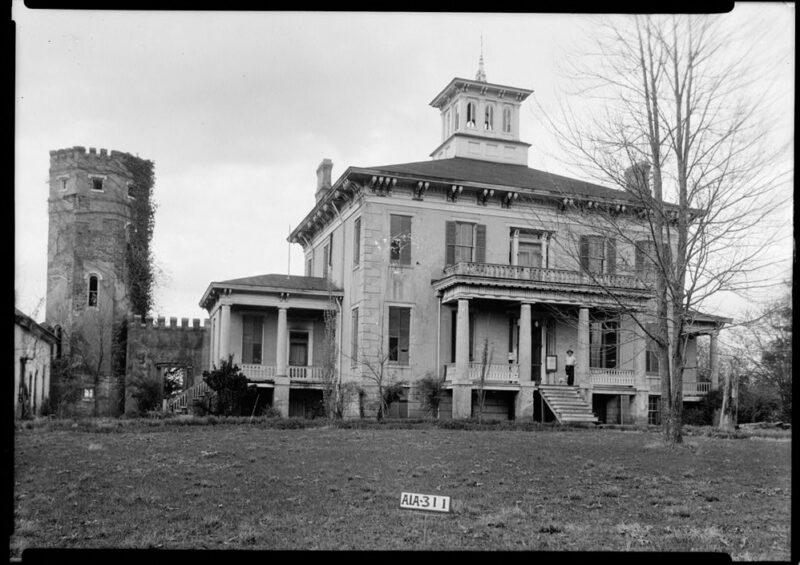
The Slave Quarters
Connected to the house on the western side by a high brick wall was a five-story brick Gothic Revival tower crowned with crenelation, which was decidedly out of keeping with the style of the main house. The connecting wall featured a Tudor arch. Adjoining the wall and the octagonal tower was a brick kitchen building.
Hammons wrote that “A Welsh carpenter named Hugh Jones had a decisive hand in the building of Rocky Hill Castle. It was he who set the pattern for the details. He carved the pilasters, designed the arches and executed the staircase. He also built the Gothic tower according to instructions from Colonel Saunders, finished it about the time the war started.“
This Gothic tower and the adjoining kitchen served as the slave quarters for Colonel Saunders’ large plantation. Hammons writes that “The brick tower with turrets has six floors and was used as a lookout post by the master as he surveyed his vast domain of fields being worked by slaves.” In the book Lost Plantations of the South, author Marc R. Matrana writes, “Here, it is said, Saunders nightly imprisoned the slaves to keep them from fleeing their bondage in the cloak of night. The tower was built with this purpose in mind, with few windows or other means of escape. It was perhaps one of the strangest and cruelest slave dwellings on any plantation in the antebellum South.“
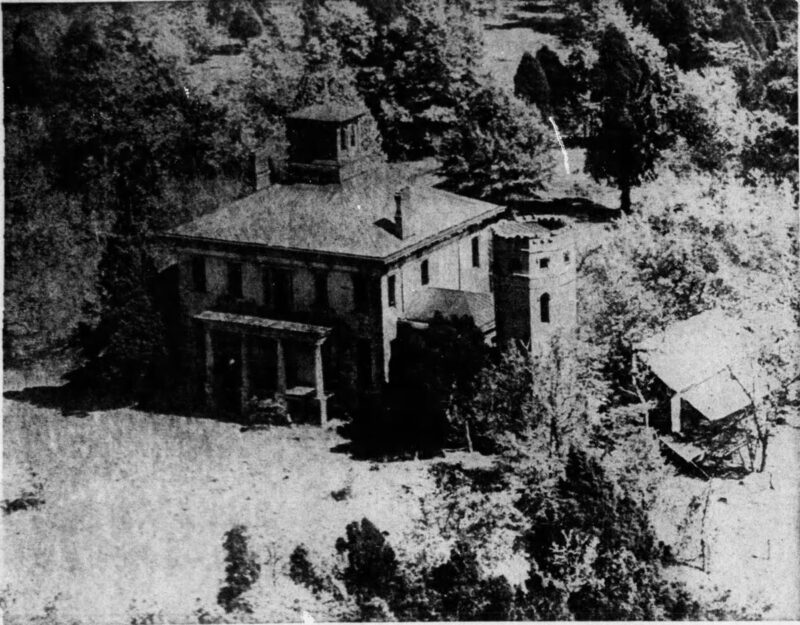
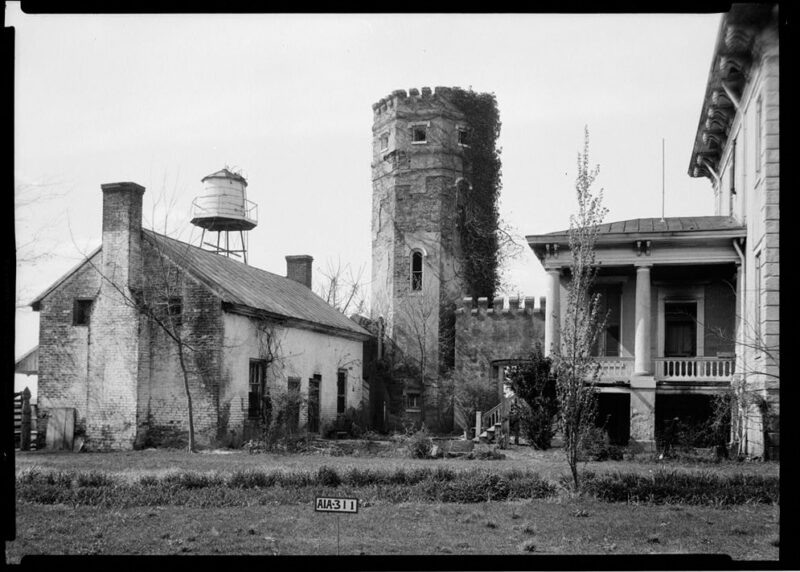
‘The Little Rebel’
Ralph Hammons wrote, “Thus one can readily see that the comings and goings of the war made opportune background when Ellen Virginia Saunders, who married Judge L. B. McFarland of Memphis, Tennessee, decided to write a novel called “The Little Rebel” which swept the nation and was made into a motion picture.“
The film he refers to is likely The Littlest Rebel (1935) starring Shirley Temple. The film takes place in 1861 in the Old South and revolves around six-year-old Virgie Cary who lives on her family plantation with her parents and Uncle Billy, the family’s slave. One stormy night, a battle raged near the plantation, forcing Virgie, her mother, and Uncle Billy to flee while their house burned down to the ground.
Having fallen gravely ill, her mother perishes in a slave cabin. Virgies’ father formulates a plan to take her to his sister in Richmond with the help of a Union officer named Colonel Morrison. The plan is foiled, and Colonel Morrison and her father are put in jail and sentenced to death. Uncle Billy and Virgie tap dance in public places to raise funds, eventually making their way to Washington where they obtain a pardon from President Abraham Lincoln for Colonel Morrison and Virgie’s father.
The book he’s referring to is War-Time Journal of a ‘Little Rebel‘ which is a collection of letters and diary entries written by Ellen Virginia Saunders, daughter of Colonel James Saunders. Although Ellen’s writings date back to the Civil War, they were not published until 1919. The play on which the movie is based on was written by Edward Peple in 1909 titled The Littlest Rebel with a book published under the same name in 1911. Although there are few similarities between Ellen Saunders’s writings and Edward Peple’s play, it’s unlikely that Ellen’s writings had any influence on Peple’s work.
Author’s Note: Throughout my research, I kept happening upon mentions of Ellen Saunders’s “The Little Rebel” although I could not find a copy of the book as it was never republished. A film based on the book is also mentioned but I can only locate two silent film shorts released in 1911 and 1914, both of which are titled “The Little Rebel”. If one happens to come across a copy of the book or one that can be viewed online, or if someone can shed more light on the subject, please email me.
Hauntings and Legends
The plantation was sold in the 1920s to Henry Drew Bynum and R. E. Tweedy, who used the farmland but did not reside in the house. This started a long period of decline for the house, which eventually became ruinous. By this time, it was no longer called “The Big House” and was known as the old “Saunders Castle” to the younger generations.
Neighbors claimed they saw the ghosts of Civil War soldiers wandering the grounds and could hear the rattling of chains from the house, purportedly those belonging to long-deceased slaves. Local folklore and legends tell of multiple spirits which haunted Rocky Hill Castle and the Saunders family. These stories were later compiled and retold by author Kathryn Tucker Windham in her book, Thirteen Alabama Ghosts and Jeffrey.
Buried Treasure
According to legend, Colonel Saunders entrusted a servant of his with guarding jewels and other valuables during the Civil War. When Union troops made their way to North Alabama, it’s said the servant buried these valuables at a spot known only to him. Sometime later, the servant became ill and was taken to Decatur for treatment. Realizing he was on his deathbed, he sent word for Colonel Saunders to come to see him. En route to Decatur, Saunders was held up by floodwaters and the servant died without revealing the hiding place of the treasure.
Although the home was unoccupied, it was still filled with furniture and objects worth a considerable sum of money. Cliff Norton was an employee of the farm and assisted J. A. Agee, the caretaker of the house. In April 1931, Norton returned from a trip to Town Creek to find that someone had broken into the house through the basement. Thinking the burglars had already left, Norton began nailing up the basement door when his daughter told him that there were lights burning in the house.
Since no one was supposed to be in the house, Norton went inside to investigate and found the burglars in the library scouring through the bookcases. When they noticed him enter the room, the burglars ran and escaped in a car that carried a New York state license plate. In regards to the treasure, Norton said that even if there were such valuables hidden there, it was long gone. Many years prior to the break-in, several men armed with pickaxes and shovels dug a series of holes in the yard, although it was never determined if they found what they were looking for.
In the 1930s, the house became occupied by employees of farm and their families. It’s unknown why the owners decided to allow employees to take up residence in the old house. Maybe they just got tired of people breaking into the house and digging up the grounds surrounding it. The Norton family occupied the slave quarters sometime in the early-1930s; Mr. and Mrs. Misha Almon moved into the downstairs of the main house sometime later; Mr. and Mrs. L. M. Gardiner and their two children lived in the upstairs portion of the home.
The Ghost of the Angry Architect
The most well-known tale was the Ghost of the Angry Architect. The story goes that Colonel Saunders had hired a Frenchman to design the main house and upon receiving the bill, was astonished as not even he with all his wealth could afford such an outlandish cost. Saunders refused to pay the bill, and the architect left Rocky Hill Castle empty-handed, cursing at its “thieving master.”
Upon his death, the architect returned to the house to haunt its halls as long as it stood. One night, the Saunders family gathered at the dining room table for dinner when they heard loud noises coming from the cellar, which sounded like someone was chipping away at the house’s foundation with a hammer. The family ran down to the cellar to investigate, but the sounds immediately stopped upon their arrival. As soon as they made their way back upstairs, the sounds resumed. The Saunders family learned to live with it, and whenever the topic came upon, they joked that the sound was the angry architect attempting to topple the house by hammering away at its foundation.
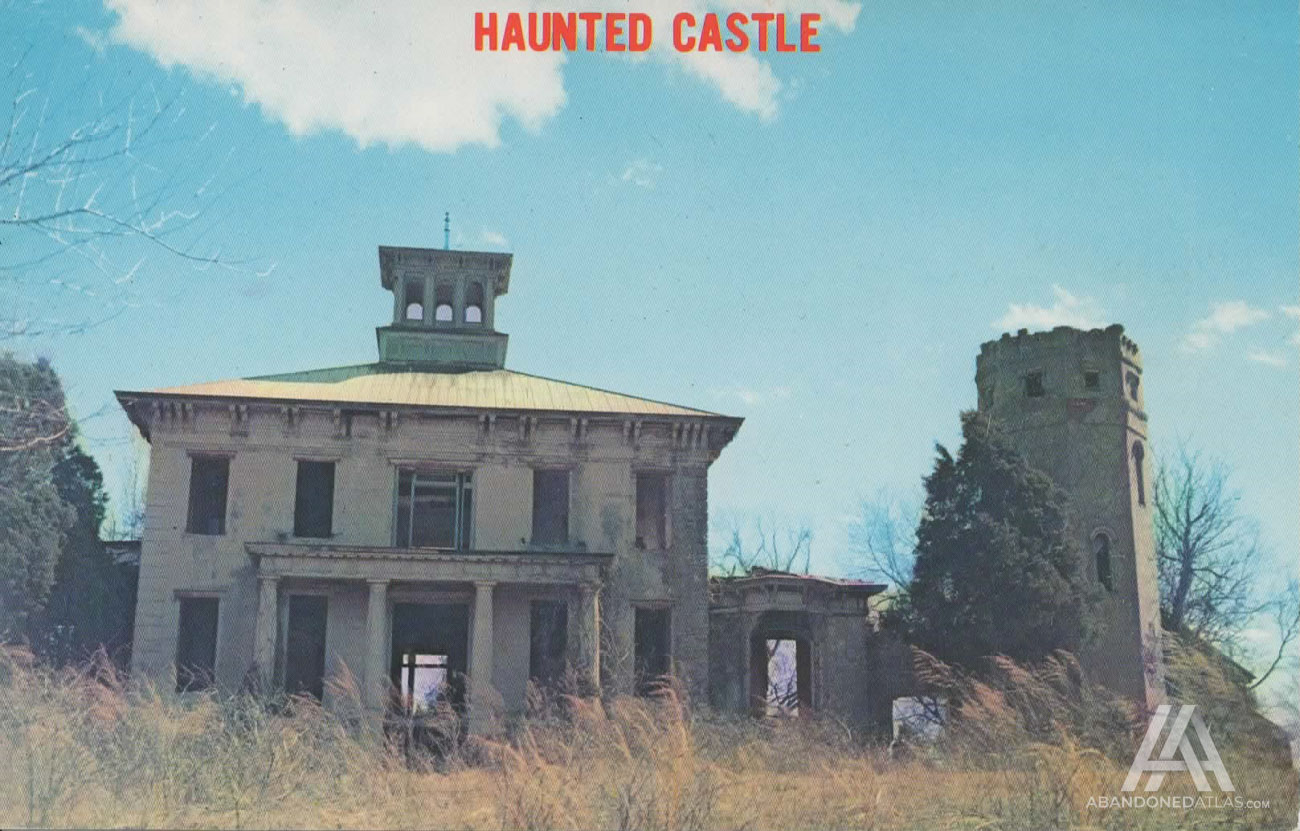
The Lady in Blue
Sometime after the Civil War, a ghostly “lady in blue” took up residence in the home. She first appeared to Mary Saunders, wife of Colonel Saunders, who was greeted by a woman dressed in a dusty blue gown standing on the staircase. As Mrs. Saunders was about to introduce herself, the mysterious woman vanished. Family members teased Mrs. Saunders whenever she recounted this encounter, that is until Colonel Saunders met this mysterious woman himself.
As he went down to the wine cellar in search of some blackberry wine, he was confronted by the “Lady in Blue” who sat in a chair and simply smiled as the two made eye contact. He locked the wine cellar and forbid anyone from entering it again. Some versions of the tale refer to the mysterious woman as the “Little Confederate Lady” while other retellings never state which generation of Saunders was involved, simply referring to them as Mr. and Mrs. Saunders.

Colonel James Saunders died on August 23, 1896, at Rocky Hill Castle and was buried at the nearby family cemetery. The plantation passed through many owners following his death, one of those being the Swopes family. Joanna Swope, the wife of Edgar Swope, claims that she saw her sister’s corpse stand up and motioned for Mrs. Swope to come closer. The sister, whose body was lying at the house before burial, had drowned after she slipped and fell while attempting to cross Big Nance Creek.
The plantation was eventually purchased by Colonel Saunders’s grandson, Dr. Dudley Dunn Saunders Jr, who would be the last Saunders to own the property. As the story goes, his wife Mary Elizabeth Wheatley Saunders grew terrified of these unexplained occurrences. While getting dressed one morning, she shouted out, “If there’s anybody there, speak up or forever hold your peace!” She immediately received a reply, “Madam, I’m right here!” Two hours later, the Saunders family moved out of the house, never to return… or so the legend goes.
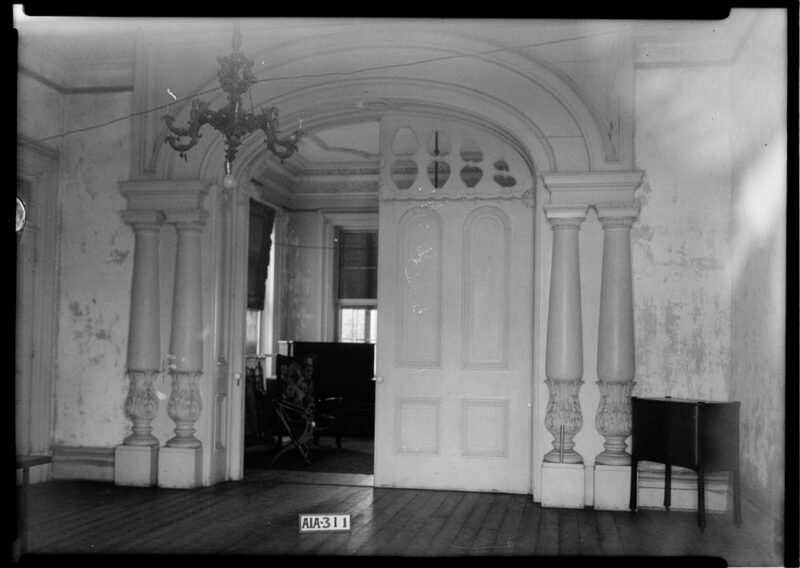
Demolition
In 1961, Gordon McBride and his wife purchased the house, but not the land, for the purpose of salvaging materials to be used in their new house in Decatur, Alabama. Every brick used in the McBrides’ new residence, located at 2321 Meadowbrook Road SE in Decatur, came from Rocky Hill Castle. Gordon McBride owned a used parts store in Decatur and sold any leftover bricks that could not be used in the new construction. Along with the bricks, the castle’s double-door entrance, some interior doors, and exposed beams in the family room and kitchen were reportedly salvaged and reused.
By the summer of 1962, Rocky Hill Castle was demolished. Decades later, a piece of the castle found its way to the Lawrence County Archives & History in the nearby city of Moulton. In February 2021, archivist Wendy Hazle was able to obtain a large, cast iron corbel once used as a type of bracket to support the roof of the old Saunders house, one of 96 other original cast-iron pieces—most of which are now lost following the demolition of the mansion. The 100lb, solid cast-iron corbel is currently on display at the Lawrence County Archives & History, along with many other historical artifacts that make their way to the facility.
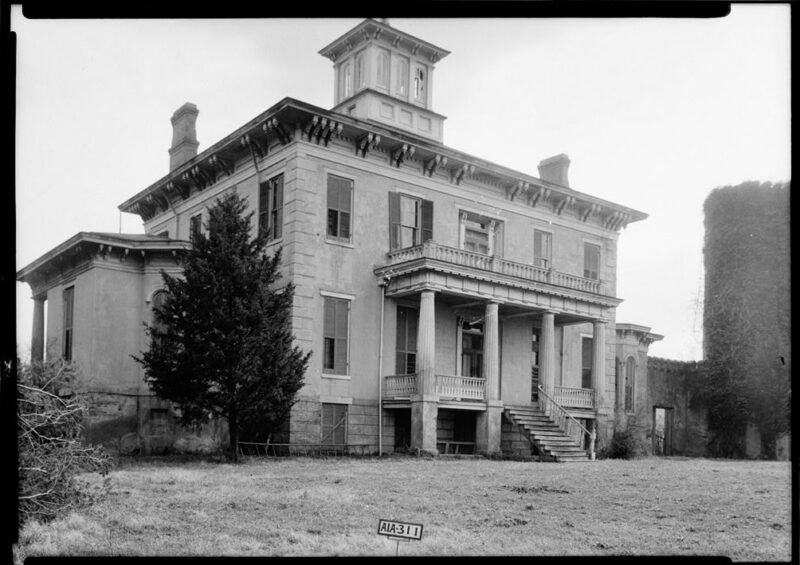
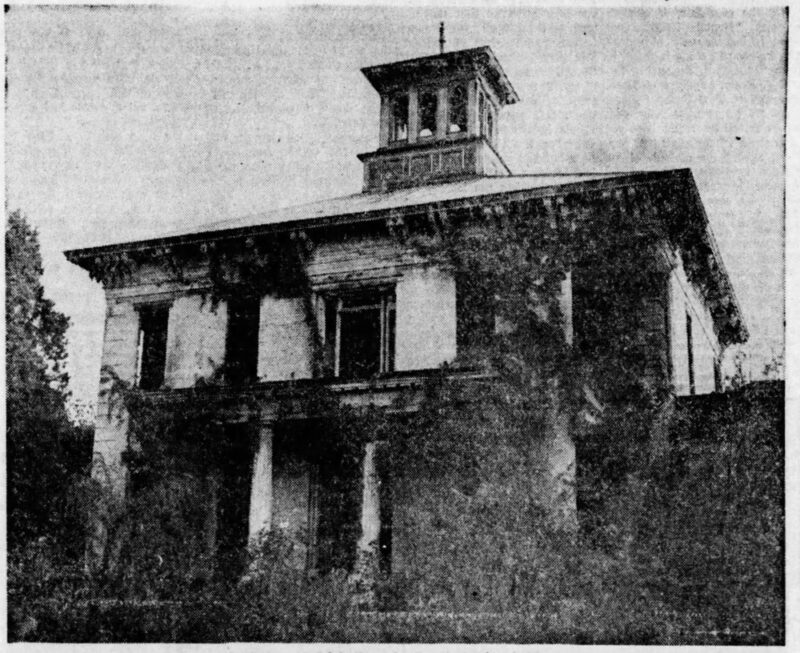
References
Early Settlers of Alabama; James Edmonds Saunders, Elizabeth Saunders Blair Stubbs. (1899)
Historic American Buildings Survey, Library of Congress. (1935). Rocky Hill, State Highway 20, Courtland, Lawrence County, AL
Lost Plantations of the South; Marc R. Matrana. (2009)
Ante-Bellum Mansions of Alabama; Ralph Hammond. (1961)
Thirteen Alabama Ghosts and Jeffrey; Kathryn Tucker Windham. (1969)
The Littlest Rebel; Edward Peple. (1911)
The Decatur Daily; Hollice Smith. (April 1, 1962). Rocky Hill Castle Going But Memories Live
The Moulton Advertiser; Chelsea Retherford. (March 11, 2021). Lawrence Archives preserves a piece of historic Rocky Hill Castle
The Decatur Daily. (November 5, 1960). Courtland Prides Its Rich History
The Birmingham News; Varian Feare. (November 15, 1936). ROCKY HILL MANSION IN HIGHLANDS
The Birmingham News. (April 22, 1931). MYSTERY OF COLONIAL HOME STIRS DISTRICT; Legend Of Hidden Money Revived As Burglars Ransack Mansion
The Birmingham New. (November 8, 1936). GHOSTS ROUTED FROM OLD COURTLAND HOME; Many Legends About Rocky Hill House Built Before War Between States

